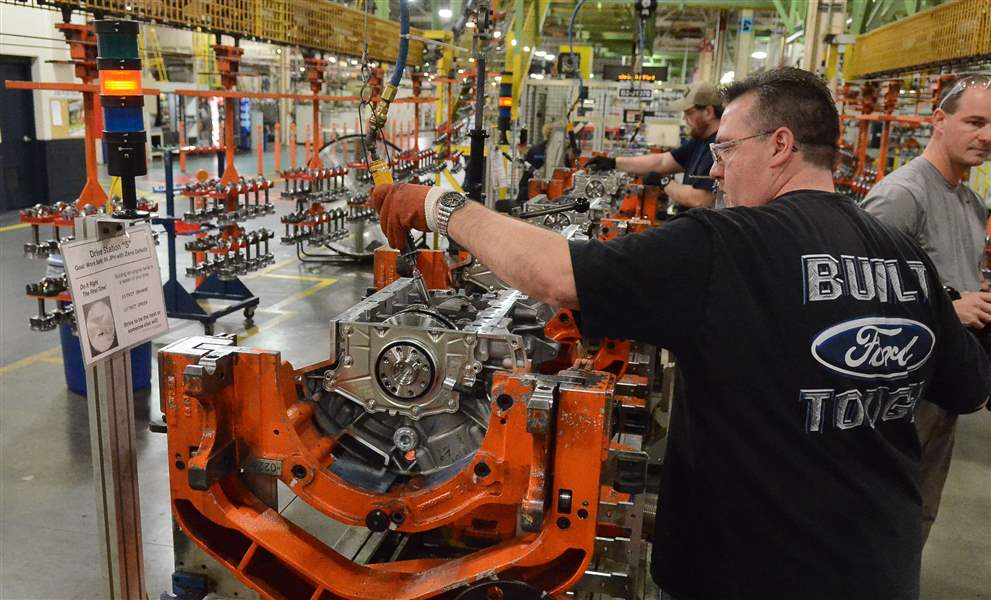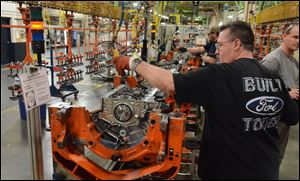
Lima looks on as Ford shifts to electric vehicles
10/8/2017
John Wooten places pistons into the new 2.7 Liter Eco-Boost engine for the 2015 F-150 while working on the assembly line at the Lima Ford Engine Plant on Friday, March 28, 2014 in Lima, Ohio.
ASSOCIATED PRESS
LIMA, Ohio — Two years ago, David Berger picked up Ashlee Vance’s biography of Tesla founder Elon Musk. He found the book so insightful he bought a dozen copies to hand out around town.
For Mr. Berger, the city’s mayor and chairman of the Lima Auto Task Force, the book was less about Musk the man and more about Musk the theory — that there’s going to be a wholesale change in transportation.
“We need to understand this, because on one side of town I’ve got the Ford Engine Plant, and on the other end of town I’ve got the refinery,” Mr. Berger said. “Massive parts of our economy would be very much affected and disrupted by the electrification trend.”
The jury is still out on Tesla. Though a darling of Wall Street, the company has yet to turn a profit.
Even so, it’s impossible to discount the shift happening within the automotive industry.

John Wooten places pistons into the new 2.7 Liter Eco-Boost engine for the 2015 F-150 while working on the assembly line at the Lima Ford Engine Plant on Friday, March 28, 2014 in Lima, Ohio.
On Tuesday, Ford announced it will cut future spending on internal combustion engines by one-third — about a half-billion dollars by 2022 — to free up capital for its pursuit of electric vehicle technology.
What that might mean for the company’s existing gasoline engine plants isn’t yet clear. But Ford’s path is sounding alarm bells in old-school manufacturing towns like Lima.
“Surely workers at Ford's U.S. plants, especially ones that make cars and engines, are on edge after the announcement that Ford will focus on sport utilities and trucks, not cars, and shift funds from gasoline engines to electric vehicles,” said Michelle Krebs, an analyst with AutoTrader.com.
Ford has had an engine plant in Lima since 1957. About 1,300 employees currently work there, building six-cylinder power plants for a variety of cars, trucks, and sport utility vehicles, including the top-selling F-150.
"We don't take anything for granted here,” said Michael Copeland, president of United Auto Workers Local 1219. “All the work we had in the past and all the work we're trying to get, we know we have to fight for."
Lately, Lima has been winning those fights.
Three years ago, Ford spent $500 million there to launch a new, 2.7-liter turbocharged V-6 for its pickups. Another $250 million was pledged for the plant in Ford’s 2015 labor agreement with the United Auto Workers to support two additional V-6 engines, though no details of that have been released.
At this point, Mr. Copeland isn’t overly concerned by what he’s heard from Jim Hackett, who took over as Ford’s president and chief executive officer in May. Mr. Hackett, he said, seems to want to work closely with the UAW and seems to have a good vision for the long-term future of the company, even if it might mean fewer vehicles with gas engines.
“I would probably be more concerned if they weren't looking at ways to keep customers happy and to keep our market share and keep our customers buying cars,” Mr. Copeland said.
And industry experts say the Lima plant is in no immediate danger. But it is possible those engine projects could be the plant’s last major new ones.
“If the cited plans hold true, there isn’t going to be the investment in internal combustion engines going forward that you’d maybe planned on six months or a year ago,” said Brett Smith, a researcher at the Center For Automotive Research in Ann Arbor.
A Ford spokesman declined to comment further on how shifting money from internal combustion to electric propulsion might affect plans like Lima.
Though the company made waves with this announcement and its January pledge to launch seven new electrified vehicles over the next five years, Mr. Smith sees the company’s moves as a long-term play that may be as much about mollifying Wall Street as they are about seeing a true sea change in the marketplace.
It’s worth noting full electric and plug-in hybrids captured less than 1 percent of the total U.S. market last year, according to research from the International Energy Agency. Traditional hybrids had about 2 percent of the market last year, according to Green Car Reports.
“That being said, when you shift that much money out of internal combustion and into electrification, you’re making quite a statement to where you think the long-term future of the industry is,” Mr. Smith said. “And in that sense, it does have implications from anyone from supplier to engineering, to the person on an assembly line.”
Ford’s CEO told investors that the company has every intention of building its electric motors in-house. However, experts say where Ford will do that has not yet been defined.
Haig Stoddard, a senior industry analyst with WardsAuto said in an e-mail to The Blade that the future of Ford’s Lima Engine Plant past 2025 may hinge on whether it gets new product programs.
“The coming of electrification will mean major changes in the manufacturing footprint in the powertrain sector, so existing engine and transmission assembly plants will have to find ways to stay competitive in order to remain viable — even if related to vehicle propulsion, that could mean building something entirely different than what they currently produce,” he said.
Mr. Stoddard said Ford’s efforts to downsize its engines could mean less volume for the largest of Lima’s V-6 engines, partially offset by more of the smaller V-6 engines. However, as Ford builds more battery-electric vehicles it will need fewer engines of any size.
“Unless it can gain new programs, the plant’s volume overall is in danger of gradually declining as Ford adds more hybrid and electric vehicles to its mix,” Mr. Stoddard said.
One of the things gnawing at Mr. Berger as he thinks about all of this is that Lima has been on the short end of a transportation revolution before.
The Lima Locomotive Works was once the city’s largest employer, topping out at more than 4,000 employees. But the company specialized in steam. As steam power fell out of favor, Lima Locomotive Works didn’t keep up. The firm went through a series of mergers before exiting the locomotive business altogether in the mid 1950s.
“I see this in the same kind of way, a disruptive technology change that we need to anticipate and we need to somehow be engaged in making sure we are part of the change,” Mr. Berger said.
Contact Tyrel Linkhorn at tlinkhorn@theblade.com, 419-724-6134, or on Twitter @TyrelLinkhorn.